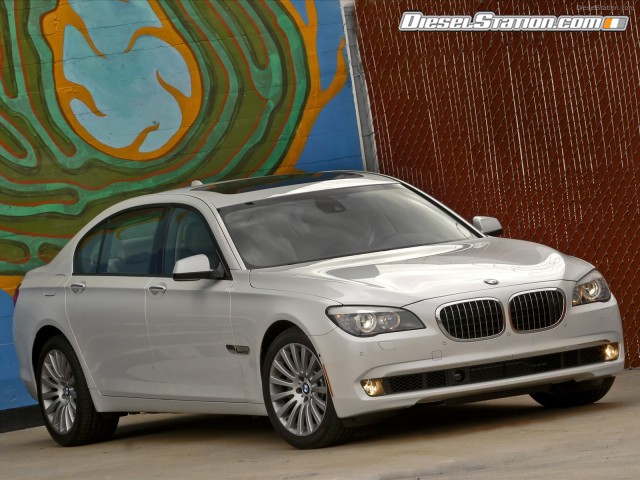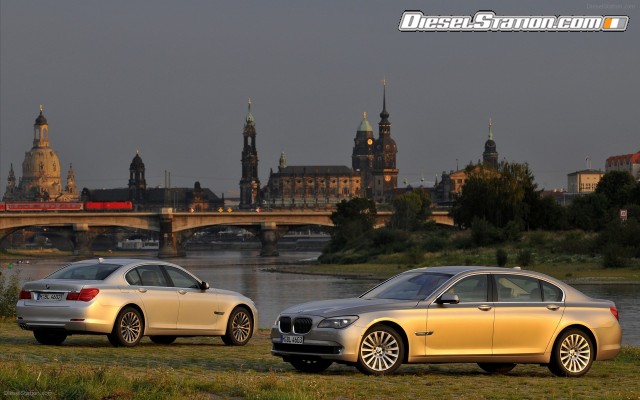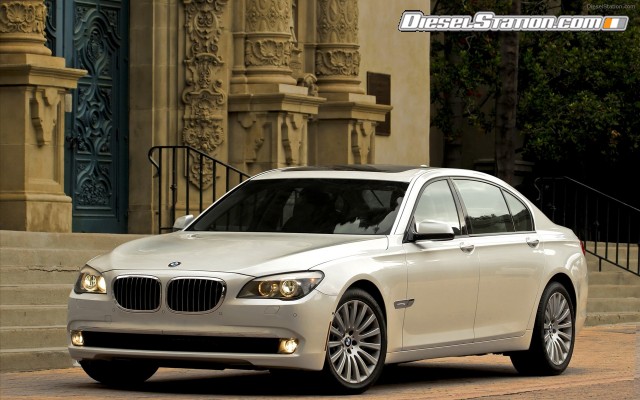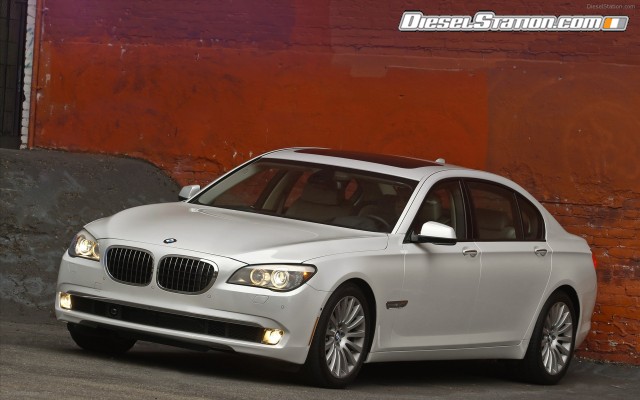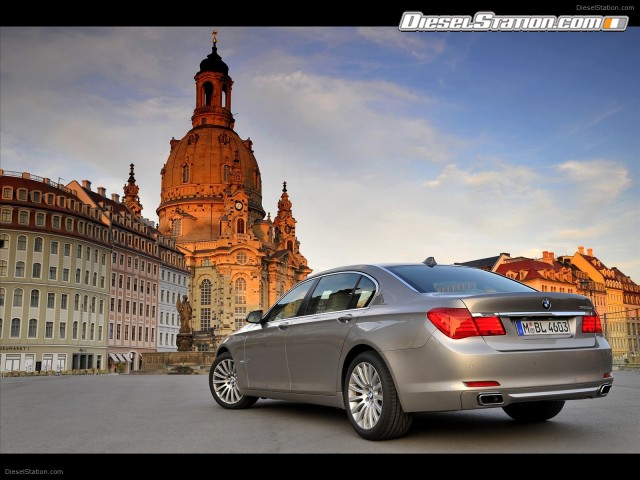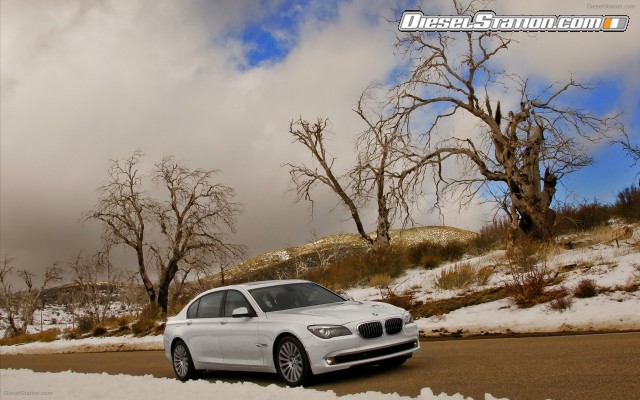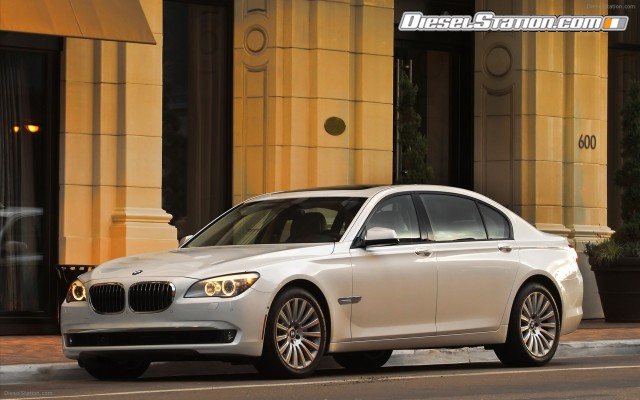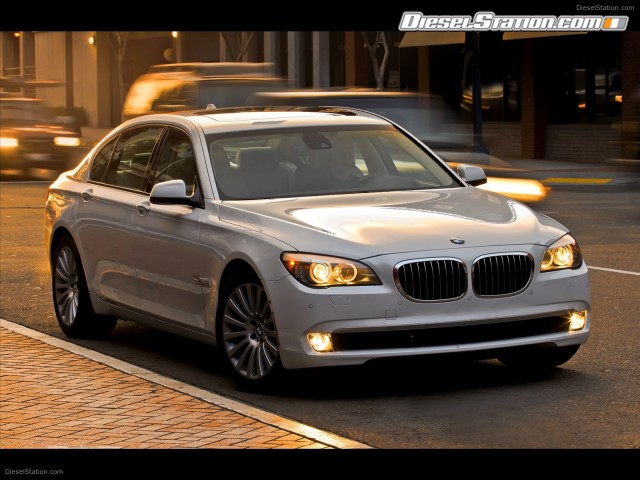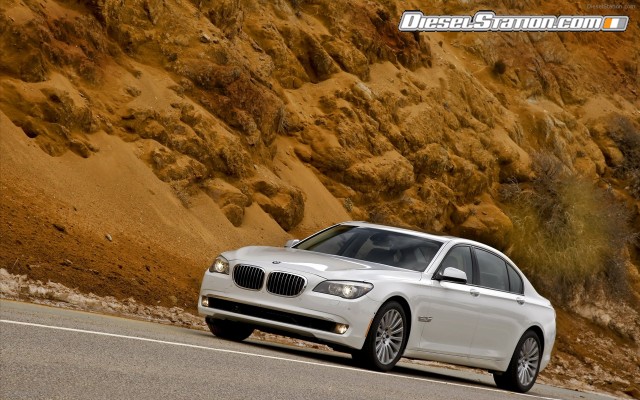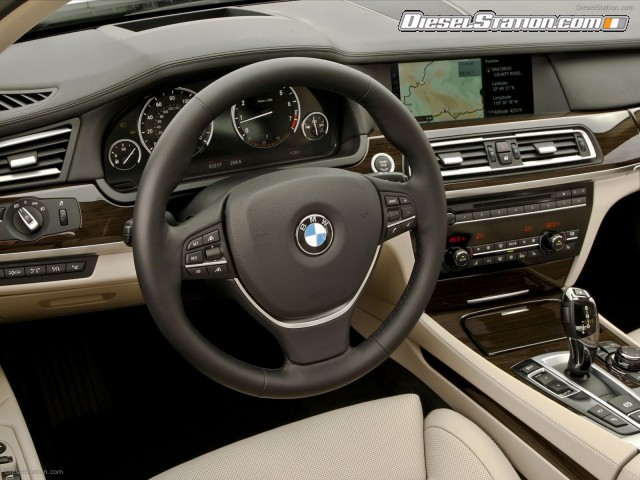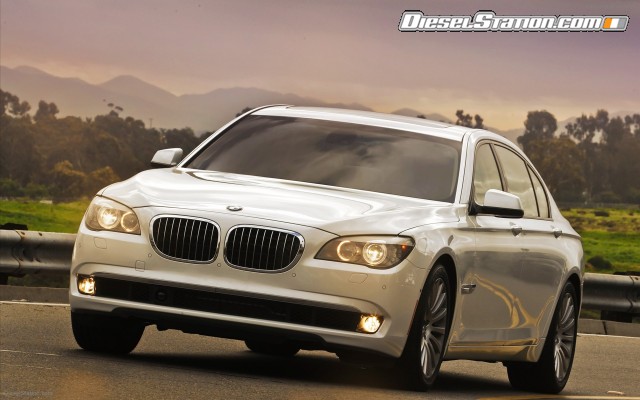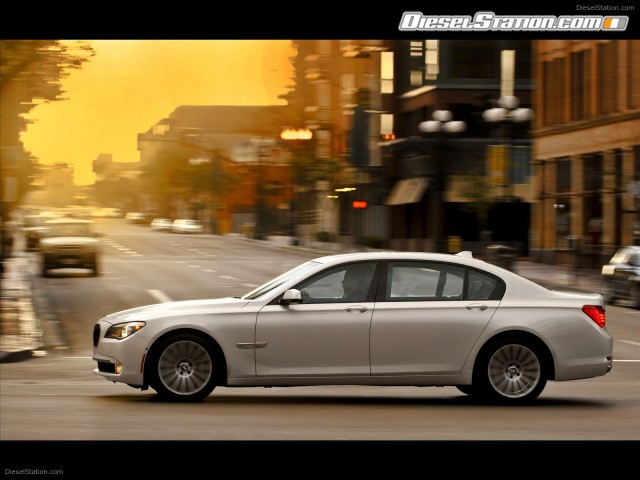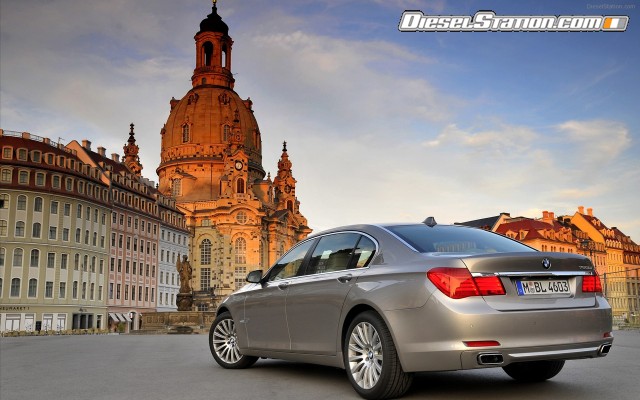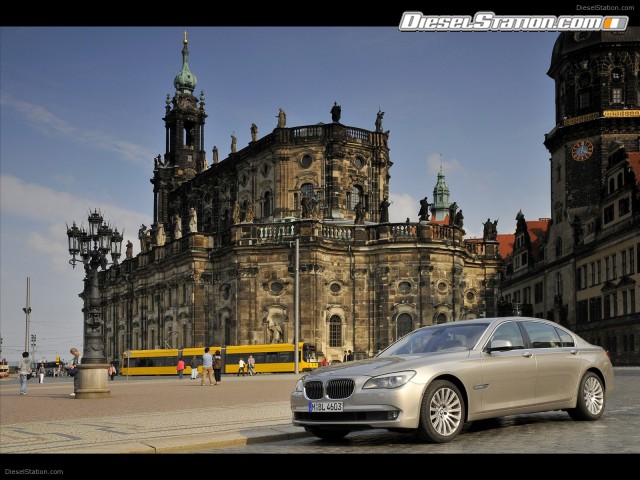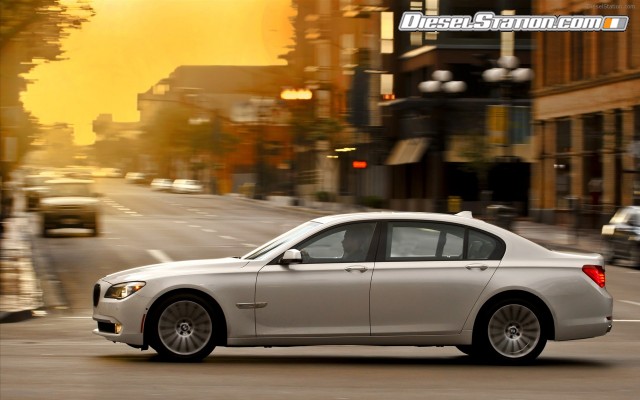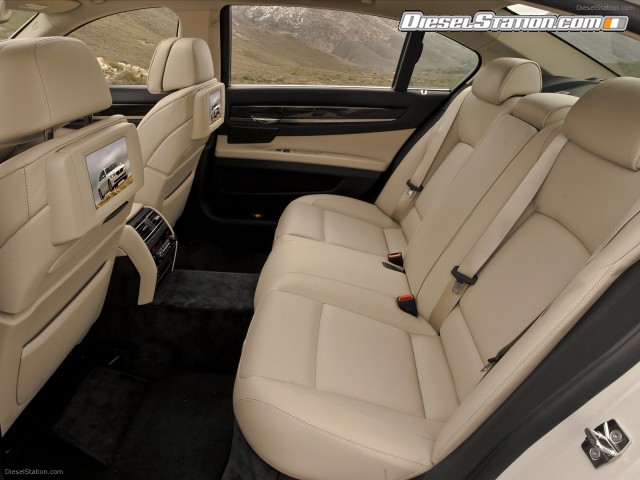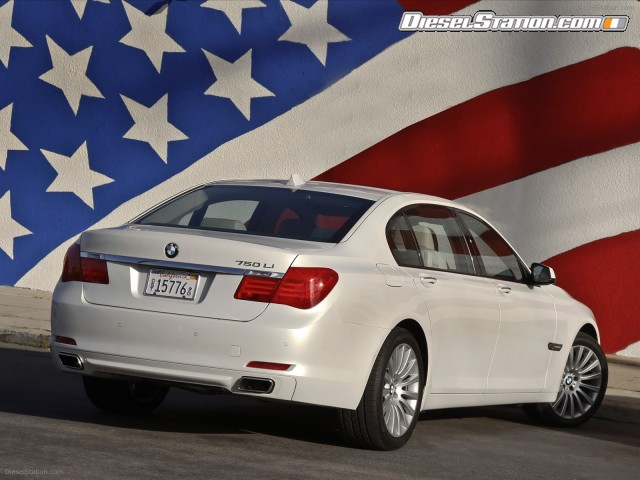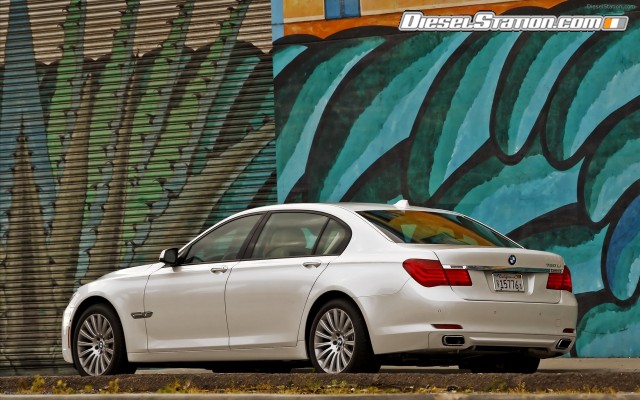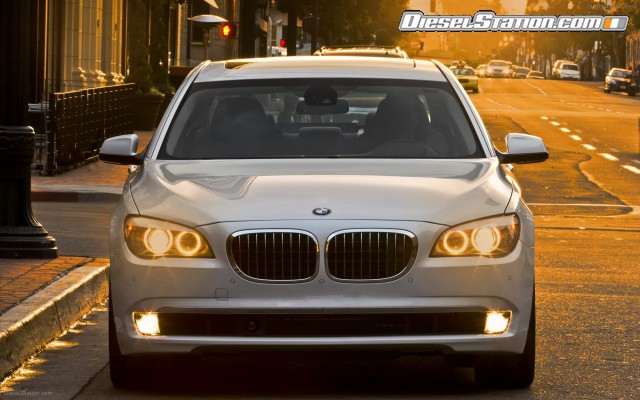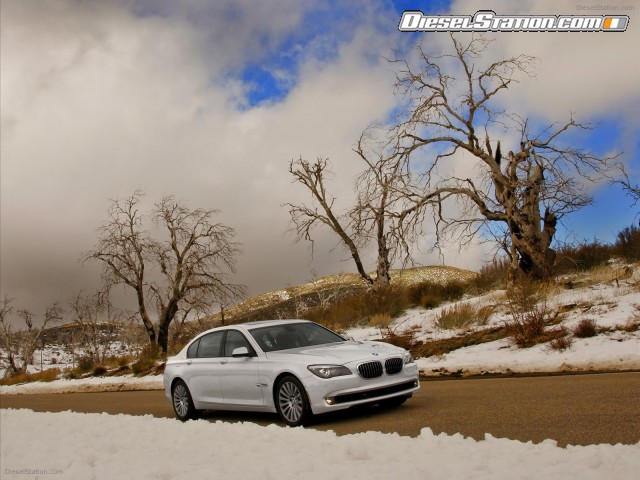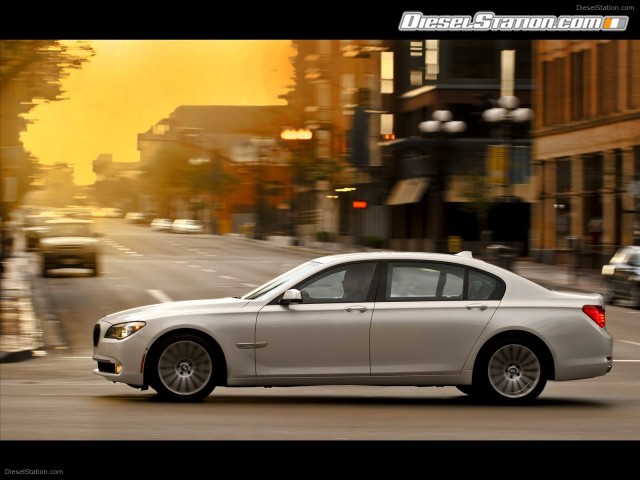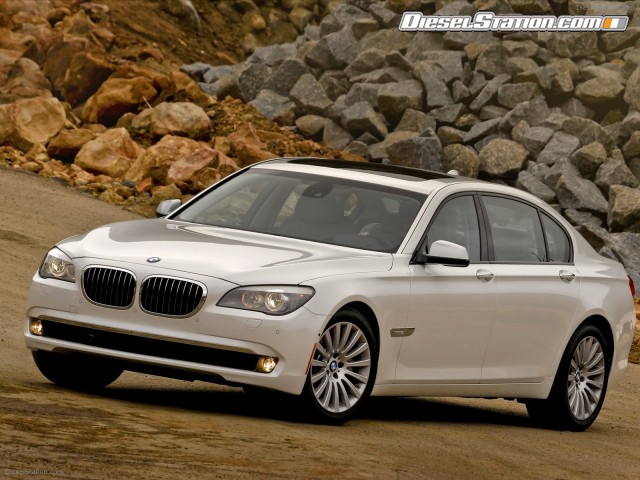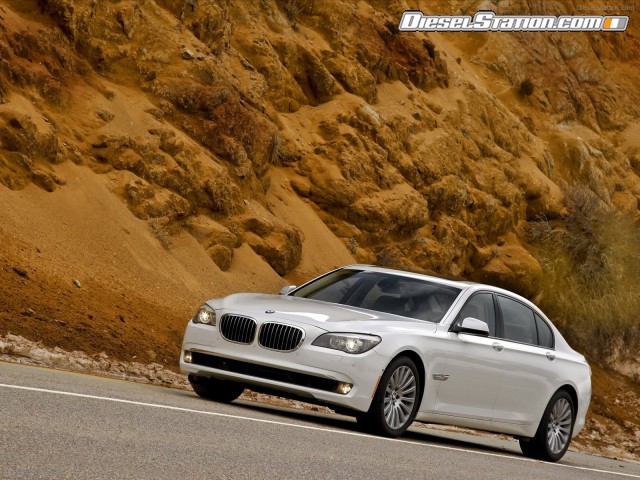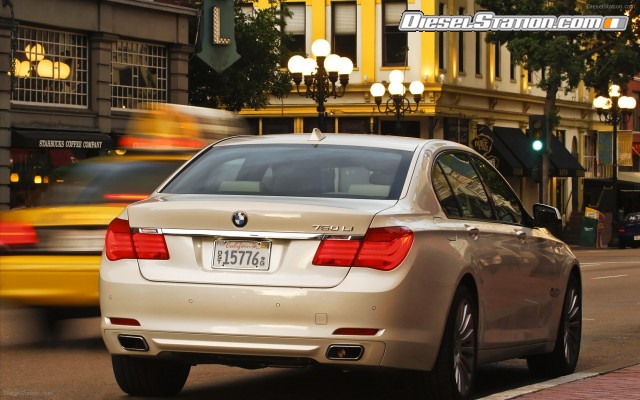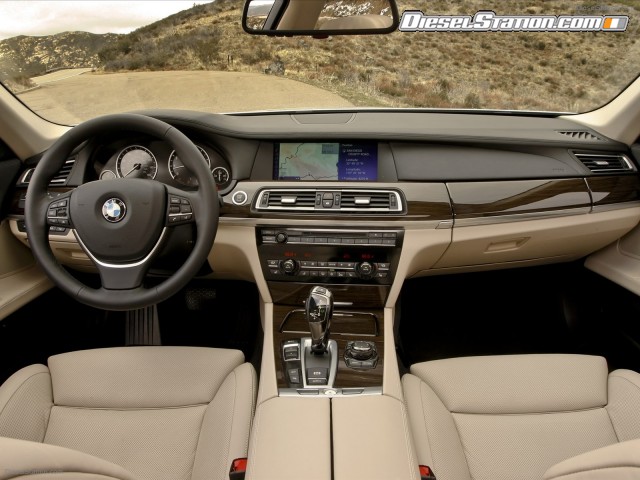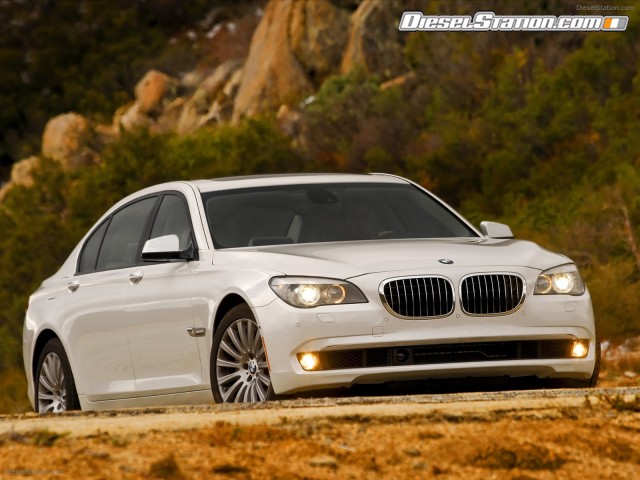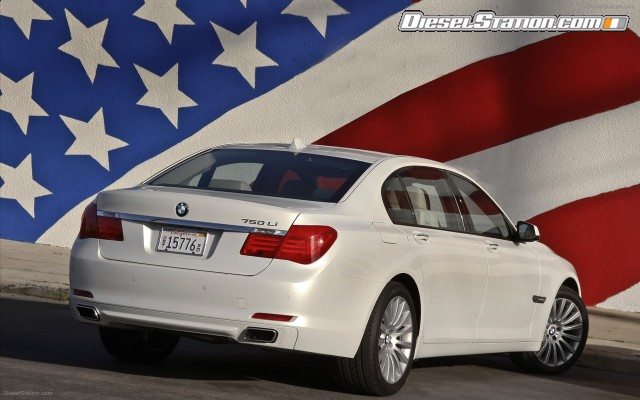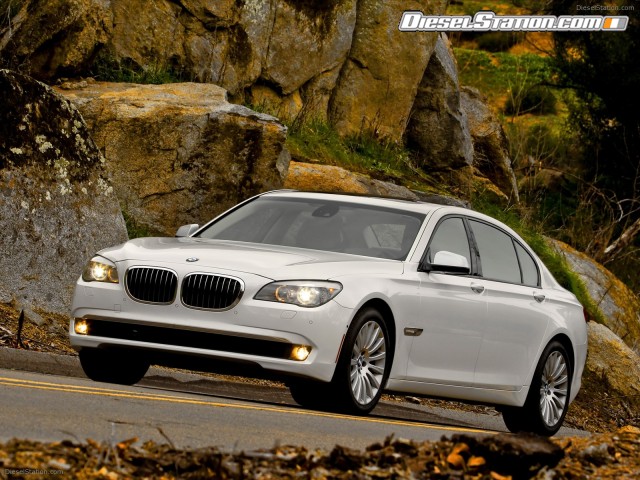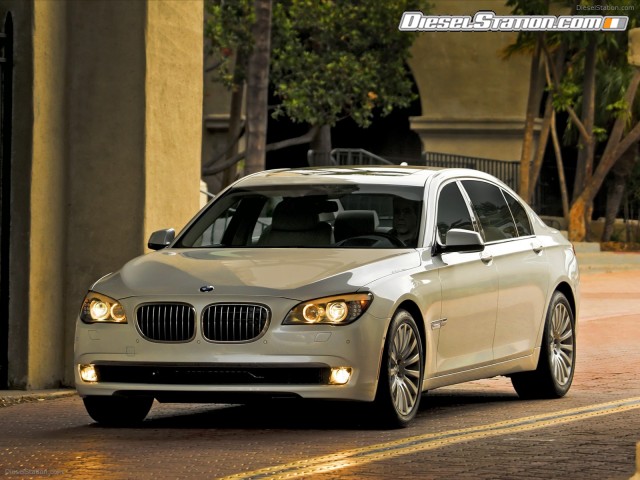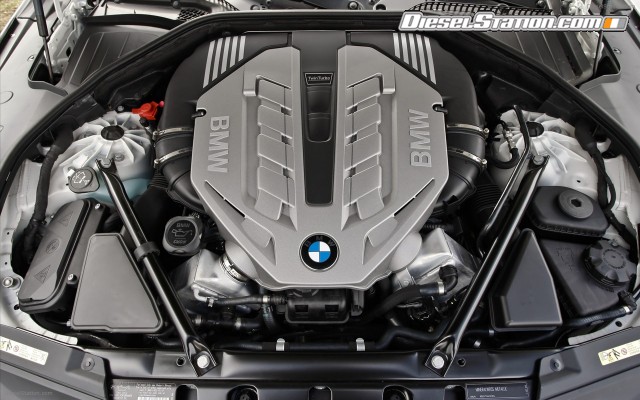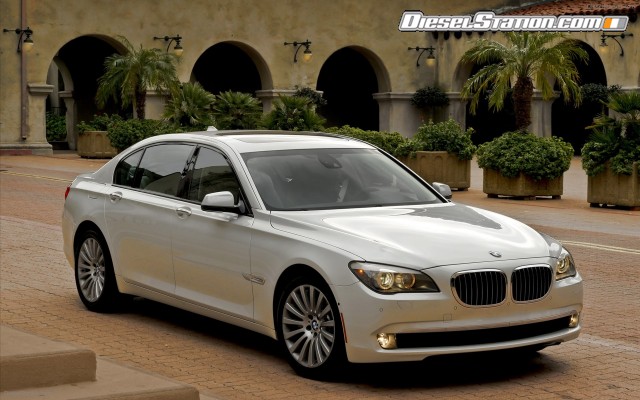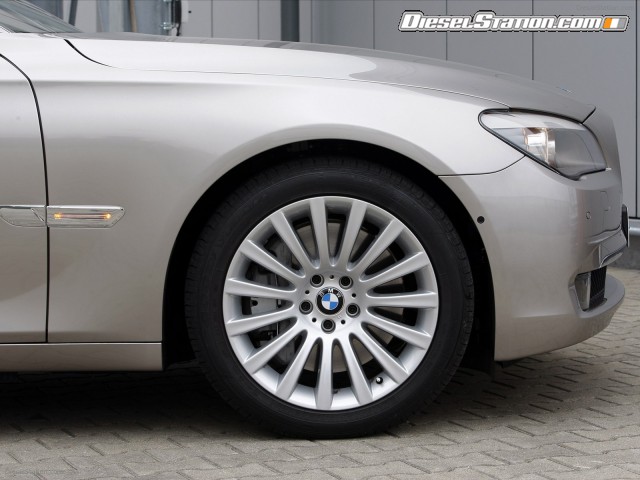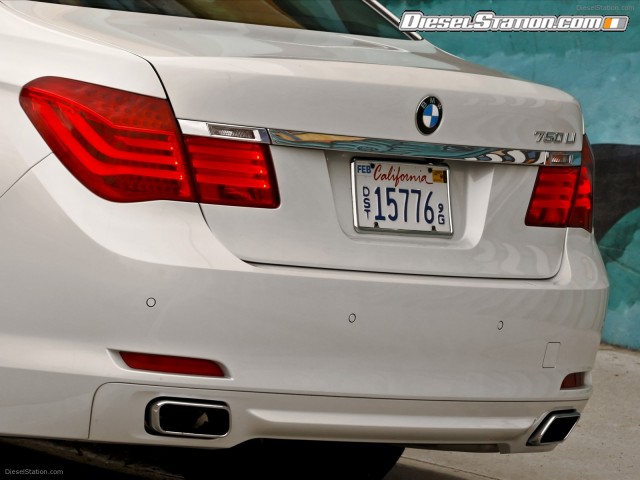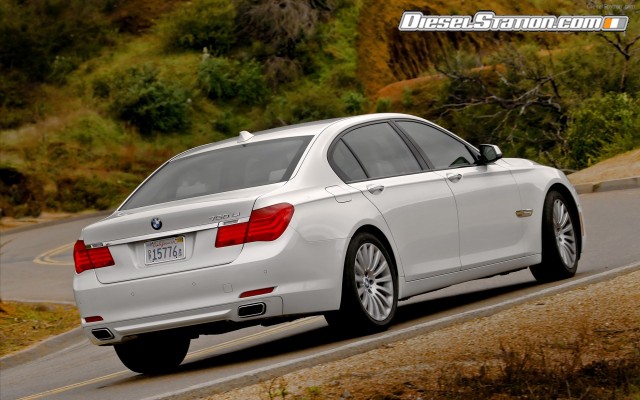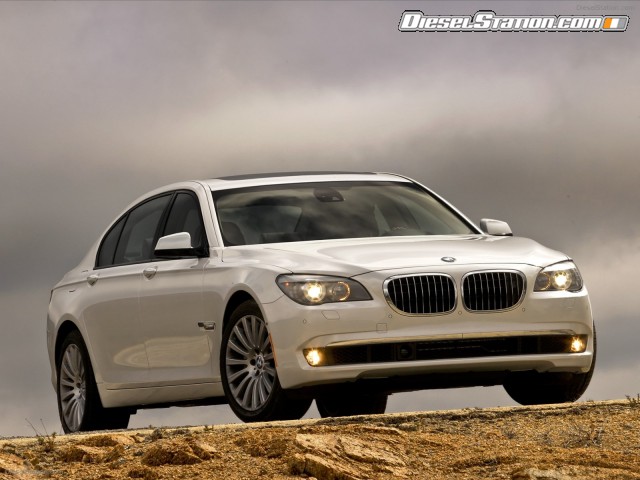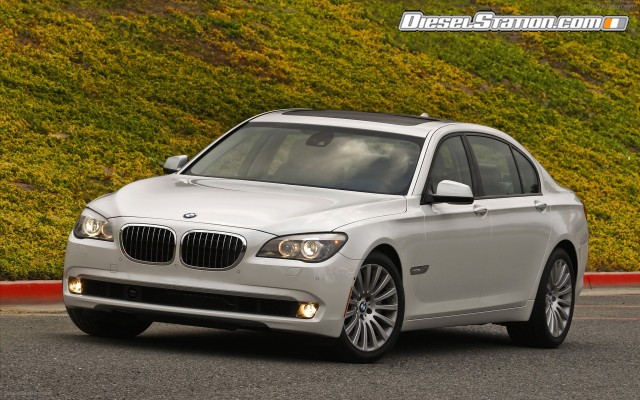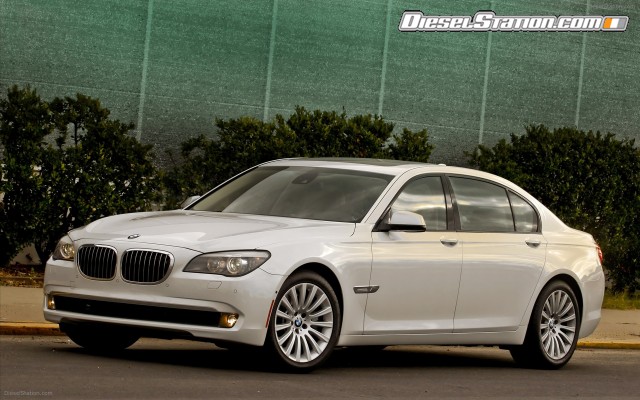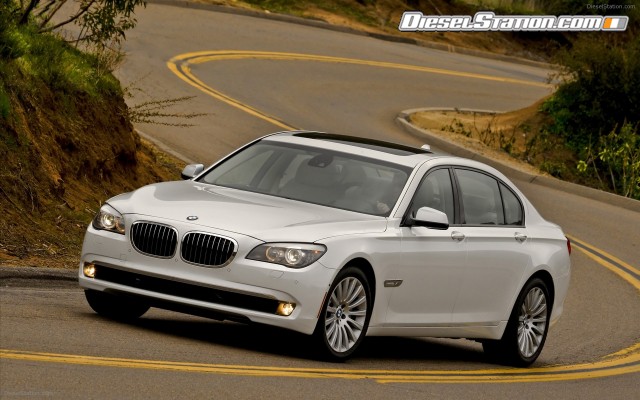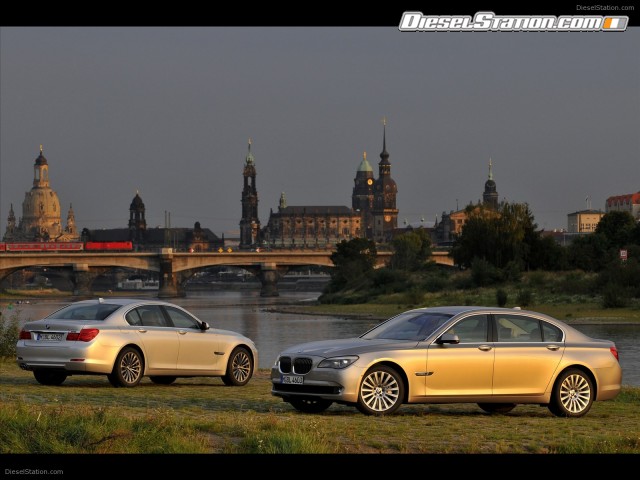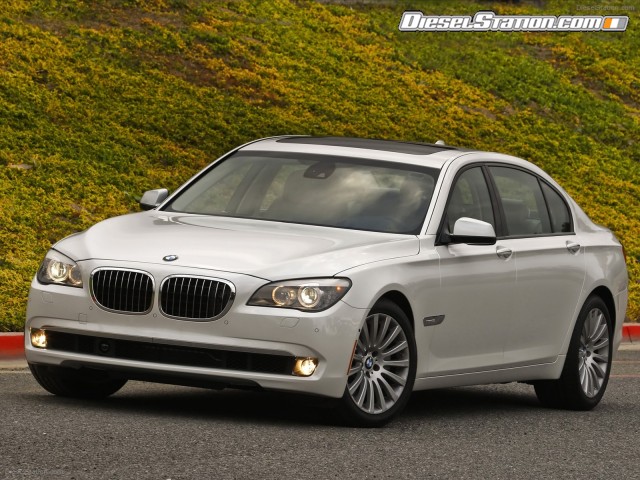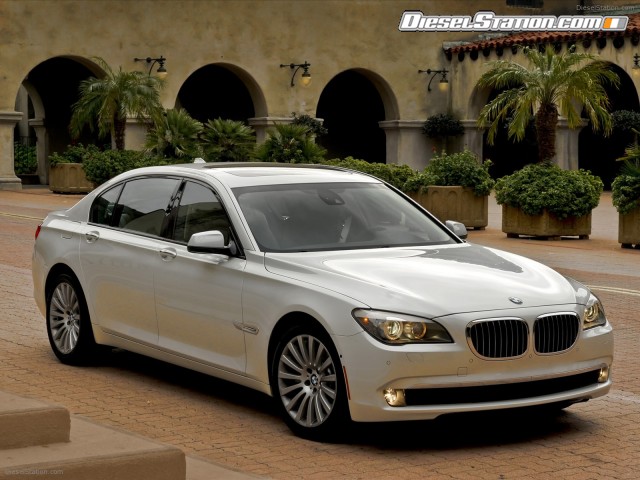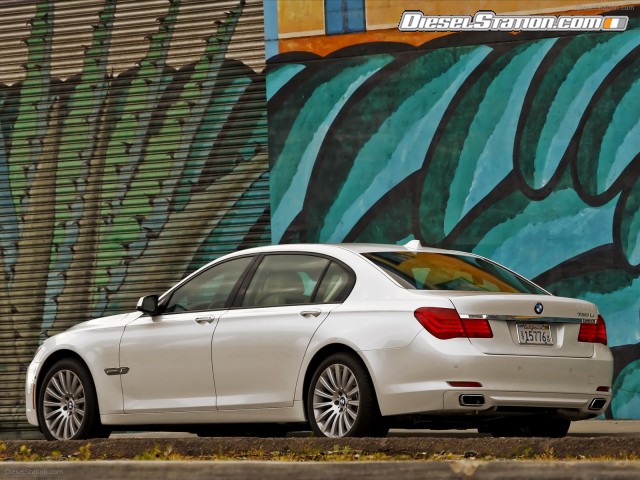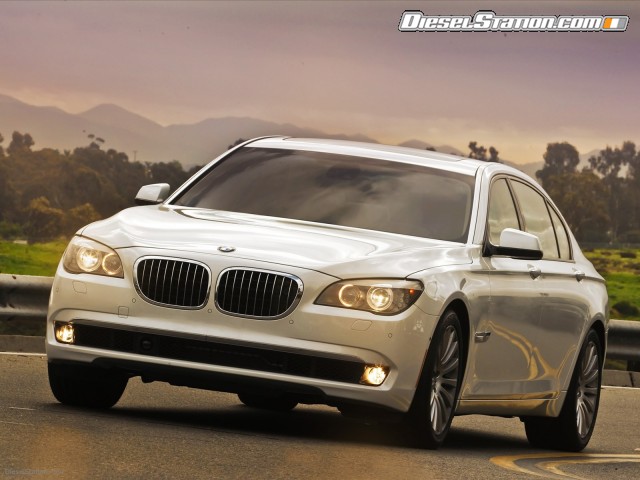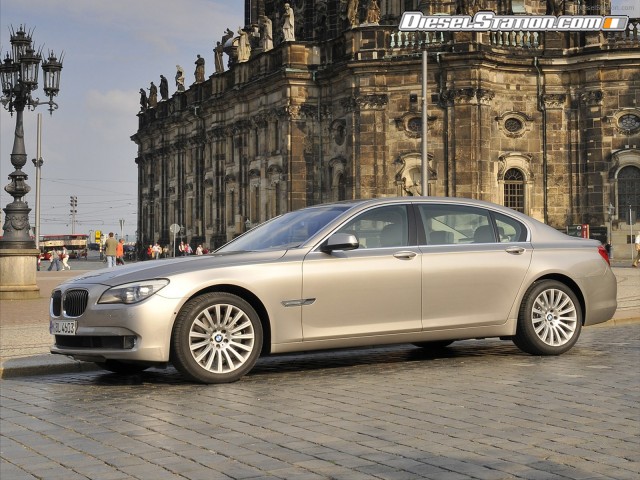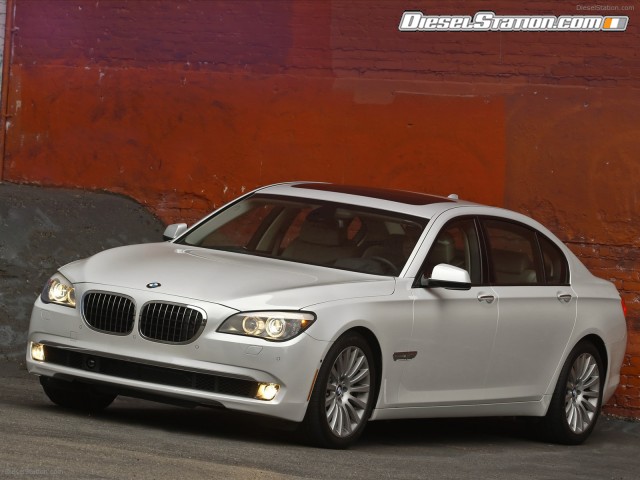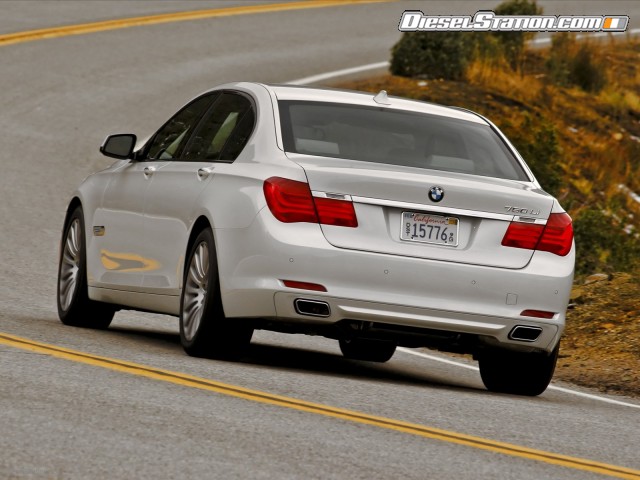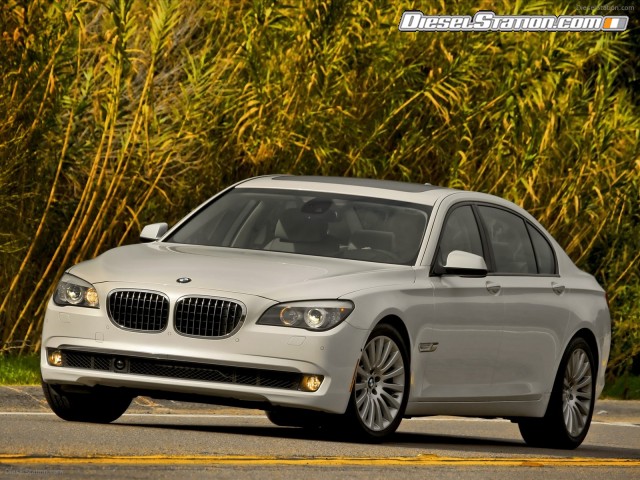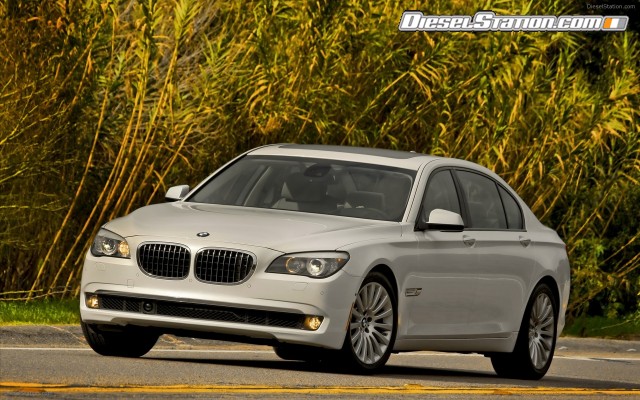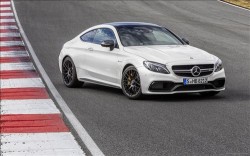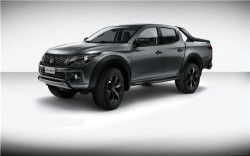The BMW 750Li is powered by a highly advanced and unique reverse flow twin-turbo V-8 engine. With 4.4 liters of displacement and direct fuel injection (BMW’s High Precision Injection), the V-8 carries its two turbochargers in the “valley” between the two cylinder banks putting its exhaust valves inboard and intake valves outboard – a highly unusual layout and a complete departure from its predecessor. This “variation from the norm” pays off: the engine develops 400 hp over a range from 5500 to 6400 rpm, and a robust 450 lb-ft. of torque over the even broader range of 1750-4500 rpm.
As an exciting example of its EfficientDynamics engineering philosophy, BMW announced the North American debut of the 7 Series with a twin-turbocharged 3.0-liter inline-6 engine. Featuring BMW’s award-winning inline-6 engine (N54 HP) that produces V-8 power with six-cylinder fuel efficiency, the new BMW 740i and BMW 740Li achieve a remarkable balance of power, efficiency, and sporty driving dynamics.
The 2011 750i and 750Li are the first 7 Series models ever to be offered with BMW’s highly lauded xDrive All-Wheel-Drive system. BMW’s xDrive all-wheel drive system has been enhanced for these models to ensure that the 750i xDrive and 750Li xDrive set a new benchmark for handling characteristics among all-wheel drive sedans. BMW’s Integrated Chassis Management is able to identify and limit understeer by shifting torque rearward (up to 80% to the rear axle) while preserving the stability for which xDrive has been so widely recognized.
As a second step, the Integrated Chassis Management system can then apply a precise combination of throttle and individual rear-corner braking in order to maintain perfectly neutral handling in a corner - regardless of road surface conditions.
These key enhancements to xDrive ensure that the 750i xDrive and 750Li xDrive will be two of the most nimble all-wheel drive sedans available in any vehicle segment.
For driving enthusiasts, model year 2010 also marks the debut of the M Sport Package for all 7 Series models. The M Sport Package includes an M steering wheel, lift-reducing aerodynamic kit, Active Roll Stabilization (RWD only), Shadowline trim, Anthracite headliner and 19" wheels with ultra-high performance tires. 20" wheels with ultra-high performance tires are available at additional cost. Carbon Black Metallic exterior paint is available with the new M Sport Package.
With the introduction of the 2010 760Li, BMW raised the standard for maximum, performance and luxury in this premium class. The new BMW 760Li Sedan has taken over the top position within BMW’s model portfolio, delivering the highest level of driving refinement in its segment.
The heart and foundation of this exceptional new vehicle comes from an all-new BMW V12 engine. Developed as a completely-new engine from the ground up, the latest BMW V12 is a masterpiece of modern engine technology. 535 horsepower comes at an engine speed of 5,250 rpm, with maximum torque of 550 lb-ft from just 1,500 rpm.
Combined with a newly developed 8-speed automatic transmission, this BMW V12 offers unparalleled driving refinement and premium driving dynamics through its ability to convert seemingly unlimited power reserves into action with amazing responsiveness. The details of the 760Li are described in a separate release.
Finally, the BMW ALPINA B7 represents the second generation of ALPINA automobiles based on the BMW 7 Series to be offered in the US. The first BMW ALPINA B7 was offered as a limited edition for the 2007 and 2008 model years. Newly interpreted and based on the current BMW 7 Series platform, the B7 will again set the benchmark in terms of performance, refinement, technology, luxury and exclusivity.
Yielding exquisite levels of power and torque from the twin-turbocharged 4.4 liter V8, and in conjunction with the electronically-adjustable suspension with active roll stabilization, the new B7 promises to offer a spectrum of driving experiences so broad as to be unheard of in this class of automobiles. The evolution of the traditional 20-spoke 21” ALPINA CLASSIC wheels underline the fresh design language found throughout the B7 and impart it a distinctive appearance and powerful stance. The details of the BMW Alpina B7 are described in a separate release.
Luxury and dynamics harmonize as never before.
The 7 Series embodies luxury that inspires, driving dynamics that enthuse, and a visual presence that earns universal admiration. It is the product of a self-assured design philosophy and consistent yet ever-evolving engineering artistry. In great measure, this new sedan owes its unique, progressive character to an abundance of innovations whose purpose is to make driving a magnificent automobile – as well as riding in it – a memorable experience.
At the core of this experience are chassis engineering that sets new international standards and all-new powertrain technology. First introduced in 2004 , BMW’s Active Steering concept comes to the 7 Series in a new, unique form: Integral Active Steering, encompassing not only the original variable-ratio front steering, but also rear-wheel steering. Acting as an overall system, the two capabilities deliver a new combination of handling ease, maneuverability and unrivaled stability in dynamic driving conditions. Integral Active Steering is available as a stand-alone option.
All 7 Series models are equipped with Driving Dynamics Control, which enables the driver to select from four progressively sporty driving programs with the touch of a button. Driving Dynamics Control integrates Electronic Damping Control (which has three-mode shock-absorber control) with transmission shift characteristics, engine response to the accelerator pedal, and steering assist and traction control level.
Active Roll Stabilization another BMW advance in handling and riding comfort, is yet another element of the available M Sport Package: Via electro-hydraulically actuated anti-roll bars, ARS reduces body “roll” or lean in cornering to a minimum, greatly enhancing the feeling of road-hugging handling.
A ground breaking engines that uniquely combines Efficiency and Dynamics.
The new 6-cylinder equipped 740i and 740Li
The 2011 BMW 740i and 740Li feature BMW’s internationally acclaimed twin-turbocharged inline-6 engine (N54 HP) with up-rated output of 315 horsepower at 5800 rpm and 330 lb-ft of torque from 1600-4500 rpm. All-aluminum engine construction, High Precision direct fuel injection, Double-VANOS variable camshaft technology, and Brake Energy Regeneration are a few of the technologies used under the BMW EfficientDynamics philosophy to place the 740i and 740Li among the most powerful six-cylinder luxury sedans in the world. Delivering power to the rear wheels is BMW’s 6-speed automatic transmission, well-known for fast, smooth gearshifts and an ability to intelligently adapt to the driver’s style.
A keystone of BMW’s EfficientDynamics philosophy is “virtual displacement,” the notion that BMW’s modern engines of smaller displacement can equal or exceed the outputs of traditional engines of larger displacement and more cylinders. This principle is already seen in the BMW 750i model, which features a twin-turbocharged V-8 engine performing at the level of BMW’s previous-generation V12 engine. Virtual displacement provides the power of a larger engine with the fuel efficiency and low CO2 emissions signature of a smaller engine.
The Unique Reverse Flow twin turbo V-8 power the 750i and 750Li
All the 750 models are powered by a highly advanced and unique reverse flow twin-turbo V-8 engine. With 4.4 liters of displacement and direct fuel injection (BMW’s High Precision Injection), the V-8 carries its two turbochargers in the “valley” between the two cylinder banks putting its exhaust valves inboard and intake valves outboard – a highly unusual layout and a complete departure from its predecessor. This “variation from the norm” pays off: the engine develops 400 hp over a range from 5500 to 6400 rpm, and a robust 450 lb-ft. of torque over the even broader range of 1750-4500 rpm.
The point of the new engineering approach is to achieve higher performance without correspondingly higher fuel consumption. In technical terms, the approach involves some very new design details. For the first time, twin turbochargers and the exhaust-cleansing catalytic converters are placed between the V-8’s two cylinder banks. In turn, this required the exhaust camshafts and valves to be inboard so that the path from cylinders to turbochargers (which are driven by exhaust gas) would be efficiently short. The intake camshafts and valves are then positioned outboard. Visually, this results in a very different-looking engine.
And an impressive-performing one. Aside from the dramatic thrust that drivers will notice subjectively, the objective data are dramatic as well: the 750i, will accelerate from 0-60mph in 5.1 seconds and the 750i xDrive reaches 60mph in 5.0 seconds flat.
As in the highly acclaimed 3.0-liter 6-cylinder twin-turbo engine in the 740 models, the use of twin low-mass turbochargers overcomes a historic drawback of turbocharging: the so-called “turbo lag” before the engine responds to the driver’s accelerator foot with strong thrust. And the twin turbos keep delivering, over that wide rpm range mentioned earlier. The effect is that of a significantly larger-displacement engine; yet this aluminum V-8 weighs less than such a larger, naturally aspirated engine of comparable performance would.
Also, contributing to the brilliant performance is BMW’s High Precision Injection, a system of direct fuel injection that sprays the precise mixture of fuel and air directly into the cylinders, rather than the intake ports.
Positioned centrally in the combustion chambers for optimum combustion, the injectors are thus subject to especially high temperatures and must deliver fuel at very high pressures. To meet BMW’s ambitious performance/efficiency/emissions goals with the necessary long-term durability, a “stack” of piezo crystals reacts lightning-fast to impulses from the engine electronics, governing the injector needle’s opening stroke and duration for ultra-precise control. According to researchers who developed this technology, it contributes 2-3% fuel savings and 20% fewer emissions.
Brake Energy Regeneration: an energy-saving innovation.
The 2011 7 Series models are amongst the first US BMW models to be equipped with Brake Energy Regeneration as part of the expansion of BMW EfficientDynamics technologies into the US market.
To save energy and reduce the vehicle’s fuel consumption, this system controls the times at which the alternator charges the battery. Conventionally, a car’s alternator runs continuously and thus charging is always available to the battery; in the 7 Series, it charges only when the vehicle is decelerating or braking; otherwise, it freewheels, drawing virtually no power from the engine. An electronically controlled clutch, somewhat similar to that used with the air-conditioning compressor, is added to engage and disengage the alternator.
Accommodating the less frequent charging is a special, more powerful “deep cycle” battery that can satisfy a contemporary vehicle’s high electrical demands without access to continuous charging. The battery uses a technology called “glass mat,” in which its internal plates are separated with saturated absorbent glass-boron silicate rather than the usual liquid electrolyte. This construction sharply reduces the battery’s conversion of charging energy to heat, and can provide the necessary electrical power for longer periods between charges.
The driver can monitor its function by the blue colored portion of the instantaneous fuel consumption gauge under the tachometer.
Precise, responsive 6-speed automatic transmission in the 6 and 8 cylinder models.
BMW pioneered the 6-speed automatic transmission with the previous 7 Series; the 7 Series evolves this concept with quicker, smoother shifting, improved torque-converter efficiency and the new-type E-Shift driver interface. Altogether, the evolutionary changes result in a more responsive, more efficient and sportier transmission.
For example, when the driver “kicks down” the accelerator, the transmission can downshift by as many as four gears – just as quickly as if it were shifting down only one gear. And the torque converter’s mechanical lockup – an efficiency-improving arrangement – is now engaged more of the time, reducing slippage and improving throttle response, especially in the lower gears.
The E-Shift driver interface controls the transmission, not by mechanically connecting the lever and transmission, but rather by electrical and electronic means. It provides Normal, Sport and Manual modes, the last executed by the driver “tipping” the lever forward for downshifts, rearward for upshifts.
BMW xDrive: intelligent all-wheel drive for enhanced dynamics and optimum traction. Now Available on the 7 Series.
Permanent all-wheel drive with electronically controlled, variable distribution of drive power between the front and rear axles gives all BMW X models not only superior traction, but also enhanced driving dynamics. Indeed, BMW xDrive gains its superiority as an intelligent all-wheel-drive system by distributing drive power front to rear by way of an electronically controlled multiple-plate clutch according to driving conditions, in exactly the right dosage and to the axle with grip.
In normal driving situations BMW xDrive distributes drive power in a 40:60 split front-to-rear, with sensors consistently measuring wheel slip. Hence, the system is able within a fraction of a second to vary the distribution of drive forces, anticipating the upcoming situation and not just responding once a wheel has started to spin. This serves to stabilize the vehicle even before the driver notices any need for action.
The xDrive system the 750i xDrive and 750Li xDrive models has been enhanced to ensure that these models set a new benchmark for handling characteristics among all-wheel drive sedans. BMW’s Integrated Chassis Management, using the remarkable speed of its FlexRay on-board network and the quick-responding xDrive hardware, is able to identify and limit understeer by shifting torque rearward (up to 80% to the rear axle) while preserving the stability for which xDrive has been so widely recognized.
As a second step, the Integrated Chassis Management system can then apply a precise combination of throttle and individual rear-corner braking in order to maintain perfectly neutral handling in a corner - regardless of road surface conditions.
An additional feature of xDrive is Hill Decent Control that is now possible on the 7 Series. Hill Decent Control is activated by a button on the center console and, using xDrive and individual brakes, is able to can automatically control the vehicle decent down a steep, icy and curvy road allowing the complete steering control. The Hill Decent Control can be programmed to maintain a set speed of 6 to 15 mph using the Cruise control rotary button on the steering wheel. Hill Decent preset speed and operation is shown in the display below the speedometer.
These key enhancements to xDrive ensure that the 750i xDrive and 750Li xDrive will be two of the most nimble all-wheel drive sedans available in any vehicle segment.
New, innovative chassis technology combines dynamics and comfort.
True to BMW tradition, the 7 Series exploited the creation of a new vehicle generation to advance the art of chassis technology and engineering. Improving both driving dynamics and riding comfort are always the core goals of the transition to a new generation, and in these regards the 7 upheld the tradition brilliantly.
Just as the engine combines sporting performance with luxurious refinement, the suspension technology endows the 7 Series with uniquely agile handling for a luxury automobile, yet also an exceptional level of riding comfort. Beyond these “basics,” these cars allow the driver to decide at any time what priority to assign to either of these attributes via the Driving Dynamics Control.
At the front, a double-wishbone system, the first such system ever in a BMW passenger car, marks a new step after BMW’s decades-long refinement of the double-pivot strut-type suspension into one of the world’s finest suspension systems. It is a multi-link type, adding an upper link (“wishbone”) to the familiar double-pivot lower links and thus relieving the strut of its role in determining suspension geometry. The double-pivot lower arms make up the lower wishbone. Another BMW specialty, the use of aluminum for links and other components, is applied here too and enhances the suspension’s response and riding comfort over rough road surfaces.
The rear suspension, too, is a significant evolution from previous generations. Like the front suspension, it is a multi-link system; BMW calls it the Integral system for its small, essentially vertical Integral Link connecting the upper and lower lateral control planes. And also as at the front, aluminum components are extensively employed.
A complex multi-link system like this controls rear-wheel angles very precisely, minimizing unwanted effects under load changes (such as lifting off the accelerator while cornering, or hard acceleration and braking) and achieving a comfortable, supple ride.
Though steel coil springs are used at the front and rear of the 750i, the long-wheelbase 750Li comes standard with electronically controlled self-leveling air springs that compensate for loads carried in the rear seat and trunk, maintaining normal vehicle height even with a full complement of passengers and luggage.
Intelligent Lightweight Design means maximum agility, efficiency and solidity.
Thanks to BMW’s Intelligent Lightweight design process, the body structure of the new 7 Series benefits from both weight efficiency and solidity. Targeted applications of higher- and highest-strength steels, as well as, aluminum for numerous elements and components allowed BMW to achieve greater passive safety, yet reduce the structure’s weight. Compared to the predecessor’s body shell, the new models are approximately 20% more rigid in torsion – which, in turn, positively influences driving dynamics. Expressed another way, the so-called “lightweight index,” which quantifies torsional rigidity relative to the vehicle footprint and weight, has been improved significantly.
Novel in the 7 Series’ market segment is its combination of a steel main structure and bonded aluminum roof: The light-metal roof saves approximately 7 kg/15 lb., and because this savings is at the vehicle’s highest point, lowers the center of gravity and further contributes to vehicle dynamics. The doors are also aluminum, saving a further 48.5 lb. As on the predecessor, the hood and front fenders are also aluminum, making for a significant contribution to these automobiles’ overall weight efficiency.
Standard Electronic Damping Control and Driving Dynamics Control.
Electronic Damping Control controls the shock absorbers to any level of firmness between their softest and firmest settings, precisely adapting to road conditions and the driver’s demands at any given moment. Ride firmness is always at the optimum level for current road conditions, vehicle speed and the load the vehicle is carrying (again, passengers and luggage). On smooth roads, the shocks are kept at the softest appropriate setting; in corners, they are instantly adjusted to a firmer, just-right level. And when the vehicle encounters any irregular road surface, they adjust to the optimum firmness level to control ride motions, preserve riding comfort and maintain adhesion to the road.
Electronic Damping Control is standard on all 7 Series models, developed to be integrally combined with the also standard Driving Dynamics Control. Driving Dynamics Control provides the driver choices of settings for shock-absorber firmness, transmission shift characteristics, engine-throttle response and power-steering assist: Comfort, Normal, Sport and Sport Plus. In addition, the traction-and-stability system Dynamic Stability Control continues with a Dynamic Traction Control setting (reduced traction intervention) that improves start-up on snow and is suitable for track-style driving.
All 750 models run on 18-in. alloy wheels, carrying all-season run-flat tires of 245/50R-18 dimensions. 19-in. wheels and performance tires with staggered sizes (245/45 front and 275/40 rear) are available as a stand-alone option or as part of the optional M Sport Package. 20-in. wheels and performance tires are optional with the M Sport Package.
New, advanced option: Integral Active Steering.
Offered in 2011 as a stand-alone option, BMW’s Integral Active Steering electronically varies the steering ratio (the number of degrees the steering wheel must be turned to achieve a 1Ëš steering angle at the front wheels) according to vehicle speed and other driving conditions. At low speeds and in parking maneuvers this ratio is decreased significantly, resulting in remarkable maneuverability and agility; as vehicle speed increases, so does the ratio, reaching a “normal” level at about 75 mph.
Integral Active Steering also includes rear-wheel steering capability. Via a steering spindle and an eccentrically positioned servo motor, the rear wheels can be steered up to a maximum of 3Ëš. At low speeds, they are steered oppositely to the front wheels; depending on vehicle speed, the turning circle can be reduced by up to 27.5 inches – which, combined with the front wheels’ reduced steering ratio, dramatically improves maneuverability. Varying the rear-wheel steering according to vehicle speed, the system steers them in the same direction as the fronts at higher speeds, which enhances the more important attribute of stability at these speeds. A further, and perhaps less expected, benefit is that the rear-wheel steering reduces the yaw rate in a given road-speed maneuver, which will be perceived by rear-seat passengers as an improvement in riding comfort.
As a result, this unique combination of Active Steering at the front and rear wheels equally benefits both comfort and agility. Yet, there’s even more: enhanced stability in braking. Linked with the sensors of Dynamic Stability Control (DSC), Integral Active Steering can also make a targeted steering correction to hinder any loss of directional control under braking on a road surface that’s uneven from one side to the other.
Secure handling via powerful brakes and comprehensive DSC functions.
Yet another active-safety advance is found in the 7 Series’ brake system. Four-wheel ventilated disc brakes are a long-standard feature on all U.S. BMW models, but until now the additional refinement of aluminum/cast-iron brake rotors has been reserved for the highest-performing 5 and 6 Series models.
In this patented construction, the brake rotor (disc) consists of two pieces: the high-carbon cast-iron outer portion, which functions conventionally as the surface onto which the brake pads grip to slow or stop the vehicle; and an aluminum “hat” in the center, which mounts the rotor to the vehicle. The concept’s advantages include reduced unsprung weight, complementing the aluminum suspension in benefiting ride comfort and road adhesion.
Reduced rotor deformation under hard braking is the other benefit. This means less tendency of the brakes to vibrate when hot, and reduced likelihood of rotors cracking under extreme heat conditions.
The brake system is also supported by the comprehensive functions of Dynamic Stability Control (DSC). These include antilock braking (ABS), Automatic Stability Control (ASC), Cornering Brake Control and Dynamic Brake Control; each of these functions contributes to vehicle stability or to braking effectiveness. Other braking enhancements via DSC include Brake Fade Compensation, which compensates for loss of braking power (fading) under hard or repeated brake use; Brake Standby, which snugs the brake pads up to the rotors if the driver suddenly removes his foot from the accelerator pedal to reduce the effective lag time in applying the brakes; and Brake Drying, which brings the pads to the rotors periodically during wet-weather driving.
Beyond these extensive functions, still others involve the use of brakes to achieve desired operational and stability goals. For example, a new Electronic Limited-slip Differential function comes into play in vigorous driving when DSC is completely de-activated. By appropriate application of only the rear brakes while cornering, DSC simulates a traditional mechanical limited-slip differential. This has the effect of better apportioning power between the two rear wheels and thus improving traction in this driving situation.
Intelligent driving dynamics via Integrated Chassis Management and FlexRay.
All such driving-dynamics functions are coordinated and overseen by BMW’s Integrated Chassis Management. Via sensing and analysis of a multitude of inputs, this powerful electronic control scheme applies and governs the interaction of these functions to ensure maximum stability. Under rapidly changing conditions, such as changing road surface, spontaneous steering input, abrupt acceleration or sudden braking, ICM reacts with ultra-quick and ultra-precise interventions via the DSC actuators, Electronic Damping Control, and – where present – Integral Active Steering and Active Roll Stabilization.
For this extremely sensitive and powerful networking of functions, the new 7 Series employs FlexRay data-transmission technology. Developed by a consortium of which BMW is a leading member, FlexRay achieves heretofore unheard-of communication speed, some 20 times that previously possible. In the 7 Series, up to 16 electronic control units can be networked; in no other current automobile can longitudinal, lateral and vertical vehicle motions be so precisely monitored and influenced. BMW is the first motor-vehicle manufacturer to offer FlexRay technology in production vehicles; it appeared first in the current X5, and is also employed in the X6.
Driving Dynamics Control.
Adjacent to the E-Shift lever on the center console is the Driving Dynamics Control selector. DDC provides four settings that tailor vehicle characteristics to different drivers, one driver’s different moods, driving conditions – or all of the above. The settings are Comfort, Normal, Sport and Sport Plus; the following vehicle-dynamics parameters are affected:
- Shock-absorber firmness (within the Electronic Damping Control system)
- Engine throttle response
- Transmission shift characteristics
- Power-steering assist level
- Dynamic Stability Control mode.
Clearly, the vehicle’s driving dynamics can be widely affected by these different calibrations of so many elements. In addition, via iDrive, the driver can program his or her preferences for all five parameters into the Sport setting for a personal, instantly-recallable mode.
Another control in this area affects Dynamic Stability Control (BMW’s all-encompassing stability- and traction-control system) alone. A brief push on this button switches the system to Dynamic Traction Control, in which DSC’s intervention threshold is raised; one effect of this setting is improved traction in deep snow. A long push on the same button de-activates DSC altogether, though one function (antilock braking) is always active.
The 7 Series has an electrohydraulic parking brake rather than the customary mechanical one; the driver sets and releases the brake with a button on the console. An Auto Hold function, which automatically holds the vehicle at a standstill and thereby eliminates “creep” when stopped in gear, is also available via an adjacent button.
Sporty BMW image – in its most elegant form.
A harmonious blend of dynamic presence and elegance is the overarching theme in the new 7 Series design. A long wheelbase (in the Li, even longer), long hood and short front overhang are basic attributes; a greenhouse set relatively rearward, a flat roofline and overall dynamic proportions say “BMW,” and at the same time “the most elegant BMW.”
At the front, headlights include BMW’s distinctive use of the “corona rings” for Daytime Running Lamps, and are accented at the top by a light band that visually unifies the traditional dual headlights on each side. The BMW “kidney grilles” – another traditional element, appearing here in new form – are notable for their boldness, verticality and low placement.
In profile, the interplay of convex and concave surfaces associated with recent BMW design appears here in extended, subtly swung contours and lines. For the first time on a 7 Series, the front side panels include a chromed “gill” that integrates the side blinker – itself a safety element – and lends character to the relatively long space between front wheelwell and windshield base. Form follows function: this proportion is a consistent attribute of BMW body design, and an outward sign of the rear-wheel drive and optimum front/rear weight balance that are BMW tenets.
The profile’s sculptural modeling makes for a graceful transition into the rear deck. Rooflines flow gracefully over the flanks all the way to the bumpers creating a sporty conclusion to this altogether graceful design. An understated chrome band connects the taillight clusters, which continue the L-shape that has become a BMW tradition. LED technology throughout makes for warm, homogeneous illumination whether tail-, brake- or turn-signal lights or even the 3rd brakelight, set into the rear window’s upper edge.
Extensive array of features enhancing forward illumination and outward vision.
It probably goes without saying that Xenon headlights are standard on the 7; but these are just the beginning of an extensive array of advanced, beneficial and enjoyable features that enhance these cars’ forward illumination.
For example, the luminous “Corona Rings” that have become a BMW identifier in recent years are now utilized for the Daytime Running Lamps, adding visual distinction to a safety precaution favored by many drivers. Adaptive control swivels the headlights according to steering input, yaw rate and vehicle speed to aid forward illumination around curves; and for the first time, the lights’ auto-leveling takes into account road topography (such as hill crests, tunnels, steep ramps) and adjusts their aim up or down as appropriate to avoid blinding oncoming drivers. At low speeds, cornering lights help the driver “see around” city corners; for backing up, on U.S. models both cornering lights (left and right) illuminate.
Advanced, luxurious, inviting: the interior.
Generous space – it goes almost without saying that occupants of the new 7 enjoy plenty of knee, head and elbow room in the front and rear compartments. Contemporary design – the ambiance is luxurious, high in quality and advanced in its amenities and functions. The contours, color coordination and choice of materials symbolize taste and harmony. With its center stack lightly angled toward the driver, the control center promotes the driver’s intuitive mastery of the vehicle: this is always a hallmark of BMW interior design. And yet this interior isn’t only for the driver; its concept, layout, technology and design focus equally on the driver’s needs and the passengers’ well-being.
The feeling of generous space and harmonious design is enhanced by horizontal color gradations pervading the entire cabin. High-quality materials and meticulous workmanship communicate the innate precision of these automobiles; details such as visible seams on the dash and door ledges, and double-framed central air outlets, are evidence of passionate devotion to details. The leatherette covering the main instrument-panel surfaces has been newly developed to be as close to leather as can be imagined – and yet soft Nappa leather here and on the door ledges is optionally available.
As always in BMW, the harmony of design and function is visible everywhere: for example, in the integration of door handles into the door panels’ chrome trim lines, or the door pulls as part of their contrasting trim material. Speaking of which: there are three choices of wood trim, four Nappa-leather interior color schemes, and the optional additional leather surfaces.
All these refinements and choices provide the interior counterpoint to the 13 available exterior colors, and enable customers to highlight classic elegance, sportiness or sheer luxury according to their personal tastes and preferences.
As the ultimate expression of the true premium nature of BMW automobiles, the BMW Individual Composition is the perfect answer for those customers who seek the utmost in luxury and look to own a more personalized 7 Series. The finest quality materials and exacting workmanship go into even the slightest details to set a BMW Individual
7 Series apart from other vehicles.
The four BMW Individual exterior colors are developed using special Xirallic paints that create constantly changing nuances in the finish, giving greater color intensity and glistening two-tone effects. The three choices of full-leather interior are fitted with the highest quality Merino upholstery, Alcantara headliner and unique interior trim choices. Illuminated BMW Individual doorsills, distinctive 20” BMW Individual wheels and a convenient passenger-side storage net provide additional premium touches to complement these exclusive 7 Series sedans.
Effective and elegant lighting, innovative Contour Moonroof.
Elegant light bars set accents on the new 7’s door handles, door panels and storage pockets. U.S. models add as standard equipment a new way of distributing ambiance lighting, whose rays are “broken” by a prism structure to bathe certain interior surfaces with a subtle glow. This harmonious illumination not only helps occupants orient themselves in the cabin at night, but also enhances the interior’s high-quality character.
An esthetic subtlety is delivered by a new moonroof design, standard on U.S. models. Its 60 x 92-cm (23.6 x 36.2-in.) glass area makes the interior feel brighter and roomier; its front edge is curved parallel to the roof’s front edge for an unusual design touch. Functional improvements figure in this concept, too: a powered interior shade replaces the former manual one, obviating the need for a handgrip recess. And the forward wind deflector rises to different height positions on the basis of vehicle speed, more effectively taming potential low-speed air drumming or high-speed wind noise.
BMW 740Li and 750Li: lavish space for rear-seat passengers.
If the standard-wheelbase 7Series already offers generous interior space, the long-wheelbase 740Li and 750Li provides truly lavish accommodations for rear-seat passengers. And in the 7, the meaning of “L” isn’t confined to just length: rather, this model also has its own roofline. This solution provides additional rear head room, as well as help maintain the dynamic proportions of the car to avoid making it look like a stretched version of the short wheel base 7 Series. Thus BMW’s typical “Joy of Driving” is complemented by the “Joy of Being Driven.”
And even this extra space can be further enhanced by two available options. Rear Comfort Seats only available in the Li model, includes individual left and right Comfort seats with multiple adjustments including fore-aft (70 mm/2.76-in. range), cushion and backrest angles, and head-restraint positions. Additionally, rear Comfort Seats also feature Active Ventilation and Active Comfort (“massage”) functions.
The Rear Entertainment Package adds yet another dimension to rear-seat luxury: a DVD player with color monitors integrated into the front seats’ backrests, controlled from a dedicated remote. This option is available on all 7 Series models.
Clear, intuitive control concept for greater driving pleasure and comfort.
Control of the many interior functions and amenities is via a freshly thought-out and executed overall concept that is clear and intuitive. To begin with the simplest aspect of this, ample storage is provided by a spacious glove compartment, bins in the door panels and pockets on the front-seat backrests. Two cupholders are on the front center console; power-seat controls are on the seats and memory controls are on the doors.
The basic concept for all controls rests upon a philosophy of a clear, functionally logical arrangement of the entire interior. Thus, driving-related functions are all on the driver’s side, comfort-related functions around the center. This principle goes for the placement of buttons, keys and levers around the cockpit, as well as, controls on the steering wheel, where those for cruise control are separated from those for the audio and phone systems.
Analogous to this “horizontal” division of functions is the arrangement of all displays in a more “vertical” separation. In the upper areas – and thus, at about the driver’s eye level – are the primary displays, such as the speedometer and tachometer (and, naturally, the available Head-Up Display). Below that are less frequently viewed instruments like the fuel and oil-temperature gauges.
At a still lower level are actual controls, optimally accessible and mostly operable without looking at them such as the turn-signal and low/high-beam/flasher stalks. Controls that need to be seen to be used are generally grouped together, for example, those for the driver-assistance functions clustered around the main lighting control: this too is highly logical, as all these support the driver’s need to perceive the vehicle’s surroundings and situations.
Everything at a glance: instrument cluster in Black Panel technology.
The new 7’s instrument cluster combines classic elements and new solutions into a complete, harmonious presentation of driving information. For the first time in a BMW, the entire cluster is a high-resolution Black Panel display, in which four classic circular instruments are most prominent; other driving-relevant displays and readouts – including GPS Navigation, vehicle-monitoring functions, upcoming service requirements and other information – also appear here in their various (and function-related) graphic forms.
In “dormant” state, this display is a mostly blank black form defined by its chrome-toned periphery and including only pointer needles, scale markings and the tachometer’s red warning zone within it. The circular instruments’ numerals, as well as the integrated displays for current fuel economy and range on remaining fuel, are entirely electronic and not visible until a door is opened.
So it is that the advantages of mechanical and electronic displays are ideally combined – with eye-catching visual and graphic effects. As the user enters the vehicle, the circular instruments’ “chrome rings,” until now open at the bottom, close and become brighter. Once the ignition is activated (upon pressing the Start/Stop button), the numerals plus all other displays and warnings illuminate. As the engine starts, functions that have been previously activated by the driver are then revealed as well.
The instrument cluster interacts in new ways with the iDrive control display and the optional Head-up Display. According to selected function, users can call up phone numbers or radio stations via the steering-wheel controls. The cluster also augments the iDrive GPS Navigation display with a further enhanced directional arrow display, which can now direct the driver to change lanes and help the driver find the correct street at a complicated or obscured intersection. If the Head-up Display is activated, the relevant directions appear primarily there; otherwise, they appear in the instrument cluster.
Current climate-control settings are indicated in a second Black Panel display in the center stack, along with all system controls. Users need not go into iDrive for any climate settings.
Innovations in Climate Control.
The 7 Series delivers technological progress in climate control and entertainment systems. The standard 4-zone automatic climate control provides for precise adjustment of airflow and temperature, free of drafts or unpleasant air turbulence. With its 4-zones, the rear-seat passengers can vary their climate independently on the left and right sides, just as in the front compartment. The 4-zone system adds a rear control panel, plus an electric heater in the rear footwells; the front center-of-dash air outlets are volume-adjustable from a gentle breeze up to vigorous air delivery.
Rear seats with Active Ventilation and Active Support.
Available for the long-wheelbase 750Li and 750Li xDrive models is a Rear Comfort Seats option consisting of multi-adjustable rear Comfort seats with Active Ventilation and Active Support, the latter being a “massage” feature. Multiple internal fans gently direct cooling air through special perforated leather on the seat cushions and backrests. Multiple internal bladders create a gentle, virtually imperceptible motion in the seating surfaces to help relax thorax, shoulder and lumbar regions promoting comfort and helping prevent cramps on longer journeys.
iDrive, 4th generation: more intuitive operation, expanded functions.
8 years ago, the predecessor 7 Series initiated a new direction in the control of vehicle features and functions with the introduction of iDrive. Using a multi-menu color display and a mouse-like controller usable by driver and passenger alike, a potentially crowded landscape of buttons and knobs was supplanted by a computer-logic control path. Now, the 4th generation of iDrive builds upon that pioneering development while making it more natural, intuitive, simpler and elegant.
An overarching attribute of iDrive was the separation of control (via the console controller) and display (the centrally placed iDrive monitor). This basic arrangement remains; the controller has been further developed and the display is larger: fully 10.2 in. vs. 8.8 in. previously.
Positioned at the same level as the instrument panel, the new control display sets higher standards for logical, readily understood menus and attractive graphics. The controller has been refined for comfortable, intuitive selection and activation of functions via standardized turn, push and tilt motions, while being augmented with more direct-selection keys.
Convincing functionality, satisfying to use: controller with direct-selection keys.
Benefiting from the newest biomechanics R&D, the state-of-the-art controller operates with tactile precision and clearly structured motions. New control elements, menu schemes and graphic representations in the control display become evident upon first use, yet user appreciation grows over the longer term. A graphic depiction of the controller in the display itself helps orient the user to the next control step; the rotation, pressing and tipping motions generally correspond to those of a computer mouse.
Thus interpreted, rotation of the controller takes the user through menu selections; pressing it makes the choice. Tilting the controller to the left or right effects navigation through various menu levels. Via clear graphic organization in the form of stacked layers and onscreen depiction of controller movements, the user enjoys highly intuitive navigation. All menus are structured according to a consistent scheme, so that one is almost immediately at ease; menus are broad so that the user can view relatively numerous options without switching to another level. Also, functions are arranged so that in longer-term use the most important options are reached more rapidly.
An additional new refinement is four direct-select keys placed directly next to the controller, for the most frequently used menus. These allow quick selection of CD, radio, phone and navigation menus, and are augmented by three further keys of general utility: one takes the user directly to the start menu (MENU), one to the most recently active menu (BACK), and the third (OPTION) presents various options within the current area. As a result, searches are likely to be shorter, or unnecessary.
Familiar and proven, yet now more useful: Programmable Memory Keys.
An iDrive enhancement recently introduced in other BMW models now comes to the 7 and represents a further user convenience: Programmable Memory Keys. Lined up above the audio controls, these eight keys allow the user to store favorite or most frequently used functions (radio stations, phone numbers, navigation destinations as an example) on various keys and recall them instantly. The stored functions can be as specific and detailed as a navigation map in the preferred scale, an audio balance setting or a selected chapter in the Integrated Owner’s Manual (about which more later). And because the keys are sensitive not just to being pressed, but also to being merely touched by the user’s finger, one can get the stored function shown on the control display by lightly touching the key. If it’s the right one, the user need only press the key and it’s there, ready to use.
Large-format display, preview maps and full-screen images.
With its 10.2-in. trans-reflective monitor, the new iDrive system doesn’t just outdo all other graphic displays in automobiledom to date; its 1280 x 480-pixel resolution means remarkably true-to-life images. It’s a system appropriate to the vehicle it’s in, achieved via up-to-date hard- and software. White-on-black menu lists; effective symbols and icons; contemporary graphics; and clear, consistent color-coding are among the elements that enhance, not only function, but also esthetics.
Menu structures, too, make finding desired functions easier. In the Start Menu, all functional areas served by iDrive are listed. Selecting a given item leads to its menu layer, where the options of that level are also listed. This consistency in navigation assists in orienting the user, as does the “stacking” of menu layers in the display. Visual assists further contribute to clarity. And if the user gets to a place where he or she didn’t mean to be, the Back key usually reverses the error.
User-friendlier GPS Navigation.
This overall refinement of functionality means simpler control of the standard GPS Navigation. Full-screen map displays offer outstandingly detailed views of the geography; maps and landmarks can be shown in 3-dimensional form. Selected points of interest along the travel route appear with near-photographic realism. For 2010, the navigation map display changes to a satellite image view once the map has been zoomed out beyond 1 mile scale.
In perspective mode, the maps are displayed with the topography of the landscape. In certain cities (such as Manhattan) zooming in to the 400ft scale within the perspective mode will render the buildings to give you a virtual view of the road ahead. Many key landmarks (such as the Empire State Building for example) are rendered in realistic detail.
Mere input of destinations reveals the new system’s impressive capabilities. If the destination appears on a list in the system, a preview map appears as the user scrolls the list; this can help distinguish between places with similar or identical names. If a destination (or a phone number) needs to be entered manually, this is done with a new, circular “speller” that makes the entry go more quickly.
Convenient combination of voice entry and controller operation.
Yet another iDrive innovation is its ability to combine voice and controller entry, called Multi-mode Input. The user can go back and forth between the two methods while actually inputting; indeed, voice recognition can remain active during input via controller and the user can modify an input via voice. Voice recognition – BMW calls it Voice Command – is activated by its function key on the steering wheel, and de-activated either upon completion of the action or by pressing the key again. Voice Command is simplified by visual display of the available commands, yet its capabilities go further in that numerous synonyms of these commands are also recognized.
This newly optimized iDrive introduces a very significant step forward in the operation of automotive features and functions. Greater efficiency, improved logic and clear, attractive displays help define the character of the new 7 Series. Indeed, the new iDrive helps the new 7 Series create a user experience that is incomparable in automotive history.
Hard drive for audio and navigation systems.
The 7 comes standard with an 80-GB hard drive, which provides fast access to navigation data and space for approximately 12GB allocated to music storage.
Music data from a CD, MP3 player or USB stick can be transferred to the hard drive then accessed at will. Via iDrive, users can enjoy programming from a personal music collection, directly from a CD or other external player, or the radio. Individual music pieces (“songs”) are listed alphabetically by their title and performer, and thus, easily located.
The standard audio system includes a DVD player and auxiliary audio input. Available options include a Premium Sound Package consisting of upgraded amplification and speakers, 6-disc DVD changer and iPod/USB adapter. The available Sirius Satellite Radio option includes a 1-year subscription to the service. HD Radio with Multicasting, which BMW pioneered as an automotive audio option is standard in the 7 Series. Two DAB (Digital Audio Broadcasting) tuners provide not only enhanced FM and AM sound, but also allow a given station’s audio program and traffic advisories to be received. Should the vehicle leave the station’s digital broadcast area, the system automatically reverts to the same station’s conventional broadcasting.
An also optional Rear Entertainment System provides two 8-in. screens integrated into the front seats’ head restraints. The system is capable of reading a DVD either from its DVD player or the DVD changer included in the optional Premium Sound System. The system allows for 1 internal input, 1 internal + 1 external input or 2 external inputs (such as a game console). The result is that each rear passenger has complete control over their respective screens.
BMW Night Vision Pedestrian Detection.
Via an infrared camera, the optional Night Vision scans a range up to 1600 ft. ahead of the vehicle over a 24-degree-wide range. Another first for the 7 is this additional capability: recognition of the direction a pedestrian near the roadway is moving. If it’s parallel to the road, the system senses and displays the presence on the iDrive screen (or, if present, Head-up Display) but doesn’t warn the driver; if the person is on a path to cross the road, it does display a warning.
Cruise control with braking ability standard; Active Cruise Control optional.
The 7 Series’ standard Cruise Control adds new functions. One is the ability to apply the brakes to maintain the set speed on longer downhill stretches; another is continuously monitoring the vehicle’s lateral acceleration and adjusting the speed if rounding a curve too quickly would upset passenger comfort.
Active Cruise Control with Stop-and-Go is optional. In addition to the speed-maintaining, acceleration and deceleration functions of the standard cruise control, ACC can adjust the BMW driver’s speed according to traffic conditions via radar sensors at the front of the vehicle. The Stop-and-Go function can bring the vehicle to a complete stop if traffic calls for it. After a stop of more than 3 seconds, the driver must step on the accelerator or select Resume to accelerate back to the set speed or whatever speed the radar sensors allow.
Driver Assistance Package: three further enhancements of outward vision.
U.S. models of the 7 offer three safety-enhancing features in the optional Driver Assistance Package.
Employing a camera near the interior rearview mirror, Lane Departure Warning monitors road lane markings. When switched on, anytime the vehicle begins to move across a lane marking without the turn signals activated, this system vibrates the steering wheel. If the driver does activate the signals, LDW does not react.
With the new Active Blind Spot Detection, radar sensors at the rear of the vehicle monitor traffic in adjacent lanes taking in an area from the driver’s blind spot rearward 60 meters/almost 200 ft. An illuminated triangular warning LED appears in the exterior mirror if there is a vehicle in this critical area. If the driver activates the turn signal, the LED blinks and, as with Lane Departure Warning, the steering wheel vibrates to warn the driver not to make a lane change.
High Beam Assist is the Package’s third feature. Controlled by a sensor on the interior rearview mirror’s forward side, switches automatically between low and high beams. With this function, the driver need not switch between low and high beams manually, thus, removing a distraction. The high beams are likely to be used more often; and other drivers and pedestrians are less likely to be blinded by high beams inadvertently left on.
All-seeing: Park Distance Control, rearview camera and sideview camera.
Park Distance Control, BMW’s ultrasonic-based parking assist system, remains standard as the 7 Series moves into its new generation. PDC warns the driver via beep tones when the vehicle approaches obstacles, at the front or rear, which may be unseen.
New, however, are both a rear-view and a side-view camera to further assist parking and maneuvering convenience and safety. Both are included in the optional Camera Package. The rearview camera transmits a high-resolution image to the iDrive control display, plus –
- A graphic representation of the vehicle’s actual path
- Static lines showing the vehicle’s trajectory with maximum steering angle (minimum turning radius). These two paths are visually differentiated from each other.
The side-view camera consists of two further cameras, one each in the front bumper’s corners, which transmit views toward the sides to the control display. This feature resolves that troublesome situation when one is emerging from, say, an alley or garage exit onto a busy street by giving the driver an advance view of traffic – and helping to avoid an accident.
Both of these camera systems are de-activated at normal driving speeds.
World’s first Integrated Owner’s Manual.
The amazing spectrum of new features, technologies and capabilities offered by the 7 Series is rounded out by yet another first: the Integrated Owner’s Manual.
Analogous to the Help functions of today’s computers, BMW now delivers the owner’s manual electronically, via iDrive. In just seconds, the user can access information on virtually any detail of the vehicle’s equipment, systems, operation, etc…like a traditional owner’s manual, only better. Subjects are presented in a multimedia format of animations, slide shows with sound and written description.
In another new-age, highly desirable departure from the traditional owner’s manual, the IOM is vehicle-specific; that is, the version that goes with each new 7 Series vehicle corresponds to that exact vehicle with its specific model designation and options. Various information paths – brief instructions, picture search, and keyword and context searches – are available to the user. The user can also store specific subjects on the Programmable Memory Keys. In addition, the IOM can be updated as appropriate via the BMW center.
Outstanding occupant protection at all seating positions.
Robust structural elements, extensive and precisely defined deformation zones, and highly efficient restraint systems coordinated by the powerful control electronics form the basis for the high level of occupant protection in the 7. Consequently, these vehicles are well positioned to achieve excellent ratings in all crash-safety tests worldwide. Impact forces are transmitted along defined paths in the floor, side, bulkhead structures and roof into deformation zones that hinder or prevent them from reaching the passenger cell. For the structures that serve as these force paths, multi-phase steels as well as a new generation of heat-formed steels have been introduced, further contributing to the structure’s weight efficiency.
Complementing the structural excellence are standard front-impact and side-impact (pelvis/thorax) airbags, as well as, a curtain-type Head Protection System. 3-point safety belts are provided at all five seating positions, all of them with force limiters and the front ones with electric pretensioners. For whiplash protection, Active head restraints are standard on both front seats. LATCH attachments (Lower Anchors and Tethers for Children) provide for securing a child restraint seat at each outboard passenger-seating position. All restraint systems are controlled by a central electronic control module that evaluates collision type and severity and activates them accordingly.
BMW pioneered Adaptive Brake Lights, whose lighting intensity increases when vehicle deceleration exceeds a certain level and thus warns following drivers that the BMW ahead is braking hard. Since their introduction by BMW, similar systems have been introduced elsewhere.
BMW Ultimate Service™:
Providing owners with incredible value and peace of mind
The 2010 BMW 7 Series will feature BMW Ultimate Service™, a suite of services that includes the BMW Maintenance Program (formerly called Full Maintenance), Roadside Assistance, the New Vehicle Limited Warranty. BMW AssistTM with TeleService is standard on all 7 Series models.
BMW Ultimate Service™ includes:
The BMW Maintenance Program is the only no-cost maintenance program in the industry that covers wear and tear items like brake pads and rotors for 4 years or 50,000 miles, whichever comes first. BMW owners pay nothing for all scheduled inspections, oil changes, brake pads, wiper blade inserts and other wear-and-tear items.
BMW Roadside Assistance is one of the industry’s most comprehensive plans available. Not only is it no-charge for the first 4 years, but there is no mileage limit. BMW drivers enjoy the assurance of on-the-road help 24 hours a day, 7 days a week, anywhere in the United States, Canada and Puerto Rico. This includes everything from flat tire changes, emergency gasoline and lock-out assistance, to towing, alternative transportation and even trip-interruption benefits. This service also includes valuable trip routing advice.
BMW New Vehicle Limited Warranty: All 2010 BMW passenger vehicles are covered by BMW’s excellent Limited Warranty, which includes:
- New-vehicle warranty – 4-year/50,000-mile coverage of the vehicle.
- Rust-perforation warranty – 12-year/unlimited-mileage coverage.
BMW Assist™ provides the driver with services that enhance on-the-road security and convenience, for added peace of mind. The BMW Assist and Bluetooth® System is standard and includes the Safety Plan for 4 years at no additional cost. BMW is the only manufacturer that offers this duration of service as other manufacturers only include the first year of service. The BMW Assist Safety Plan is a subscription based service that is subject to certain limitations.
The in-vehicle equipment for BMW Assist includes GPS technology and hands-free communication functions to deliver emergency and other services, accessed via buttons in the overhead or center console. The BMW Assist system transmits the location and vehicle information to the BMW Assist Response Center. A response specialist speaks with the vehicle occupants to coordinate dispatch, notify emergency contacts on file, and link BMW Roadside Assistance or emergency services as needed and/or requested. A severe accident automatically activates the Automatic Collision Notification function. The BMW Assist Safety Plan also includes Door Unlock and Stolen Vehicle Recovery services, which can save the owner time and money. New to BMW Assist is MyInfo, which allows users to send business listings and street addresses with associated phone numbers from the internet, directly to their BMW.
TeleService automatically notifies the BMW center when the vehicle will need service. A service advisor then proactively calls the customer to set up a convenient appointment and have the needed parts ready.
BMW Assist subscribers can also enroll in the BMW Assist Convenience Plan (available at an additional cost








